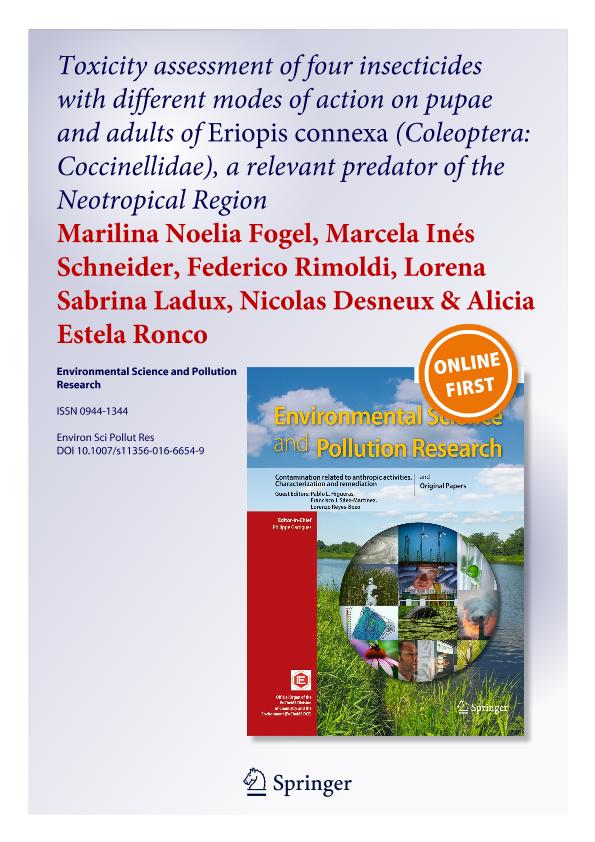Mostrar el registro sencillo del ítem
dc.contributor.author
Fogel, Marilina Noelia

dc.contributor.author
Schneider, Marcela Inés

dc.contributor.author
Rimoldi, Federico

dc.contributor.author
Ladux, Lorena Sabina

dc.contributor.author
Desneux, Nicolas
dc.contributor.author
Ronco, Alicia Estela

dc.date.available
2018-06-21T15:28:50Z
dc.date.issued
2016-08
dc.identifier.citation
Fogel, Marilina Noelia; Schneider, Marcela Inés; Rimoldi, Federico; Ladux, Lorena Sabina; Desneux, Nicolas; et al.; Toxicity assessment of four insecticides with different modes of action on pupae and adults of Eriopis connexa (Coleoptera: Coccinellidae), a relevant predator of the Neotropical Region; Springer Heidelberg; Environmental Science and Pollution Research; 23; 15; 8-2016; 14918-14926
dc.identifier.issn
0944-1344
dc.identifier.uri
http://hdl.handle.net/11336/49534
dc.description.abstract
Pesticides can be toxic to nontarget organisms including the natural enemies of agricultural pests, thus reducing the biodiversity of agroecosystems. The lethal and sublethal effects of four insecticides with different modes of action—pyriproxyfen, teflubenzuron, acetamiprid, and cypermethrin—were evaluated on pupae and adults of Eriopis connexa, an effective predator in horticultural crops. Pupal survival was reduced by pyriproxyfen (26 %) and cypermethrin (41 %). Malformations in adults emerged from treated pupae were observed after acetamiprid (82.7 and 100 % for 100 and 200 mg a.i./l, respectively), pyriproxyfen (48.6 %), and cypermethrin (13.3 %) treatments. A longer mean oviposition time was also observed in adults emerged from pupae treated with cypermethrin. Moreover, the latter insecticide as well as teflubenzuron did not reduce reproductive parameters, whereas females emerged from pyriproxyfen-treated pupae were not be able to lay eggs even when females showed large abdomens. Upon exposure of adults, survival was reduced to approximately 90 % by acetamiprid, but no reduction occurred with pyriproxyfen, teflubenzuron, or cypermethrin though the fecundity at fifth oviposition time of the female survivors was reduced. Pyriproxyfen decreased the hatching at all the oviposition times tested, whereas fertility was reduced in the fourth and fifth ovipositions by teflubenzuron and in the first and third ovipositions by cypermethrin. In conclusion, all four insecticides tested exhibited lethal or sublethal effects, or both, on E. connexa. The neurotoxic insecticides were more harmful than the insect-growth regulators, and pupae were more susceptible than adults. The toxicity of insecticides on the conservation of predators in agroecosystems of the Neotropical Region is discussed.
dc.format
application/pdf
dc.language.iso
eng
dc.publisher
Springer Heidelberg

dc.rights
info:eu-repo/semantics/openAccess
dc.rights.uri
https://creativecommons.org/licenses/by-nc-sa/2.5/ar/
dc.subject
Eriopis Connexa
dc.subject
Insecticides Selectivity
dc.subject
Lethal Effects
dc.subject
Sublethal Effects
dc.subject.classification
Meteorología y Ciencias Atmosféricas

dc.subject.classification
Ciencias de la Tierra y relacionadas con el Medio Ambiente

dc.subject.classification
CIENCIAS NATURALES Y EXACTAS

dc.title
Toxicity assessment of four insecticides with different modes of action on pupae and adults of Eriopis connexa (Coleoptera: Coccinellidae), a relevant predator of the Neotropical Region
dc.type
info:eu-repo/semantics/article
dc.type
info:ar-repo/semantics/artículo
dc.type
info:eu-repo/semantics/publishedVersion
dc.date.updated
2018-06-18T14:17:27Z
dc.journal.volume
23
dc.journal.number
15
dc.journal.pagination
14918-14926
dc.journal.pais
Alemania

dc.journal.ciudad
Heidelberg
dc.description.fil
Fil: Fogel, Marilina Noelia. Consejo Nacional de Investigaciones Científicas y Técnicas. Centro Científico Tecnológico Conicet - La Plata. Centro de Estudios Parasitológicos y de Vectores. Universidad Nacional de La Plata. Facultad de Ciencias Naturales y Museo. Centro de Estudios Parasitológicos y de Vectores; Argentina. Universidad Nacional de La Pampa. Facultad de Ciencias Exactas y Naturales; Argentina
dc.description.fil
Fil: Schneider, Marcela Inés. Consejo Nacional de Investigaciones Científicas y Técnicas. Centro Científico Tecnológico Conicet - La Plata. Centro de Estudios Parasitológicos y de Vectores. Universidad Nacional de La Plata. Facultad de Ciencias Naturales y Museo. Centro de Estudios Parasitológicos y de Vectores; Argentina. Universidad Nacional de La Plata. Facultad de Ciencias Naturales y Museo; Argentina
dc.description.fil
Fil: Rimoldi, Federico. Consejo Nacional de Investigaciones Científicas y Técnicas; Argentina. Universidad Nacional de La Pampa. Facultad de Ciencias Exactas y Naturales; Argentina
dc.description.fil
Fil: Ladux, Lorena Sabina. Consejo Nacional de Investigaciones Científicas y Técnicas. Centro Científico Tecnológico Conicet - La Plata. Centro de Estudios Parasitológicos y de Vectores. Universidad Nacional de La Plata. Facultad de Ciencias Naturales y Museo. Centro de Estudios Parasitológicos y de Vectores; Argentina
dc.description.fil
Fil: Desneux, Nicolas. Institut National de la Recherche Agronomique; Francia
dc.description.fil
Fil: Ronco, Alicia Estela. Consejo Nacional de Investigaciones Científicas y Técnicas; Argentina. Universidad Nacional de La Plata. Facultad de Ciencias Naturales y Museo; Argentina
dc.journal.title
Environmental Science and Pollution Research

dc.relation.alternativeid
info:eu-repo/semantics/altIdentifier/doi/https://dx.doi.org/10.1007/s11356-016-6654-9
dc.relation.alternativeid
info:eu-repo/semantics/altIdentifier/url/https://link.springer.com/article/10.1007%2Fs11356-016-6654-9
Archivos asociados
